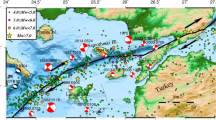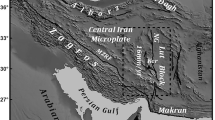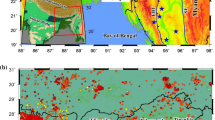Abstract
In this study, we attempt to improve the standards in Probabilistic Seismic Hazard Assessment (PSHA) towards a time-dependent hazard assessment by using the most advanced methods and new databases for the Calabria region, Italy. In this perspective we improve the knowledge of the seismotectonic framework of the Calabrian region using geologic, tectonic, paleoseismological, and macroseismic information available in the literature. We built up a PSHA model based on the long-term recurrence behavior of seismogenic faults, together with the spatial distribution of historical earthquakes. We derive the characteristic earthquake model for those sources capable of rupturing the entire fault segment (full-rupture) independently with a single event of maximum magnitude. We apply the floating rupture model to those earthquakes whose location is not known sufficiently constrained. We thus associate these events with longer fault systems, assuming that any such earthquake can rupture anywhere within the particular fault system (floating partial-rupture) with uniform probability. We use a Brownian Passage Time (BPT) model characterized by mean recurrence, aperiodicity, or uncertainty in the recurrence distribution and elapsed time since the last characteristic earthquake. The purpose of this BPT model is to express the time-dependence of the seismic processes to predict the future ground motions in the region. Besides, we consider the influence on the probability of earthquake occurrence controlled by the change in static Coulomb stress (ΔCFF) due to fault interaction; to pursue this, we adopt a model built on the fusion of BPT model (BPT + ΔCFF). We present our results for both time-dependent (renewal) and time-independent (Poisson) models in terms of Peak Ground Acceleration (PGA) maps for 10% probability of exceedance in 50 years. The hazard may increase by more than 20% or decrease by as much as 50% depending on the different occurrence model. Seismic hazard in terms of PGA decreases about 20% in the Messina Strait, where a recent major earthquake took place, with respect to traditional time-independent estimates. PGA near the city of Cosenza reaches ~ 0.36 g for the time-independent model and 0.40 g for the case of the time-dependent one (i.e. a 15% increase). Both the time-dependent and time-independent models for the period of 2015–2065 demonstrate that the city of Cosenza and surrounding areas bear the highest seismic hazard in Calabria.










Similar content being viewed by others
References
Akinci A (2010) HAZGRIDX: earthquake forecasting model for ML ≥ 5.0 earthquakes in Italy based on spatially smoothed seismicity. Ann Geophys 53(3):51–61. doi:10.4401/ag-4811
Akinci A, Galadini F, Pantosti D, Petersen M, Malagnini L, Perkins D (2009) Effect of time dependence on probabilistic seismic-hazard maps and deaggregation for the central Apennines, Italy. Bull Seismol Soc Am 99(2A):585–610. doi:10.1785/0120080053
Akinci A, Perkins D, Lombardi AM, Basili R (2010) Uncertainties in the estimation of the probability of occurrence of strong earthquakes from individual seismological sources in the Apennines, Italy. J Seismol 14:95–117
Akkar S, Bommer JJ (2010) Empirical equations for the prediction of PGA, PGV, and spectral accelerations in Europe, the Mediterranean, and the Middle East. Seismol Res Lett 81(2):195–206. doi:10.1785/gssrl.81.2.195
Anderson JG, Luco JE (1983) Consequences of slip rate constraints on earthquake occurrence relations. Bull Seismol Soc Am 73:471–496
Basili R, Valensise G, Vannoli P, Burrato P, Fracassi U, Mariano S, Tiberti MM, Boschi E (2008) The Database of Individual Seismogenic Sources (DISS), version 3: summarizing 20 years of research on Italy’s earthquake geology. Tectonophysics 453:20–43. doi:10.1016/j.tecto.2007.04.014
Beeler NM, Simpson RW, Hickman SH, Lockner DA (2000) Pore fluid pressure, apparent friction, and Coulomb failure. J Geophys Res 105(B11):533–542
Bindi D, Pacor F, Luzi L, Puglia R, Massa M, Ameri G, Paolucci R (2011) Ground motion prediction equations derived from the Italian strong motion database. Bull Earthq Eng. doi:10.1007/s10518-011-9313-z
Boore DM, Atkinson GA (2008) Ground Motion prediction equations for the average horizontal component of PGA, PGV, PGD, and 5% damped PSA art spectral periods between 0.01 and 10.0 s. Earthq Spectra 24(1):99–138
Castello B, Selvaggi G, Chiarabba C, Amato A (2006) CSI Catalogo della sismicità italiana 1981–2002, versione 1.1. INGV-CNT, Roma. http://csi.rm.ingv.it/. Accessed 8 April 2015
Cauzzi C, Faccioli E (2008) Broadband (0.05 to 20 s) prediction of displacement response spectra based on worldwide digital records. J Seismol 12:453–475
Cocco M, Rice JR (2002) Pore pressure and poroelasticity effects in Coulomb stress analysis of earthquake interactions. J Geophys Res. doi:10.1029/2000JB000138
Console R, Catalli F (2006) A rate-state model for aftershocks triggered by dislocation on a rectangular fault: a review and new insights. Ann Geophys 49(6):1259–1263
Console R, Murru M, Falcone G, Catalli F (2008) Stress interaction effect on the occurrence probability of characteristic earthquakes in Central Apennines. J Geophys Res. doi:10.1029/2007JB005418
Convertito V, Emolo A, Zollo A (2006) Seismic-hazard assessment for a characteristic earthquake scenario: an integrated probabilistic-deterministic method. Bull Seismol Soc Am 96(2):377–391
D’Agostino N, Selvaggi G (2004) Crustal motion along the Eurasia-Nubia boundary in the Calabrian Arc and Sicily and active extension in the Messina Straits from GPS measurements. J Geophys Res. doi:10.1029/2004JB002998
Del Ben A, Barnaba C, Taboga A (2008) Strike-slip systems as the main tectonic features in the Plio-Quaternary kinematics of the Calabrian Arc. Mar Geophys Res 29(1):1–12. doi:10.1007/s11001-007-9041-6
Delavaud E, Cotton F, Akkar S et al (2012) Towards a ground-motion logic tree for probabilistic seismic hazard assessment in Europe. J Seismol 16:451–473. doi:10.1007/s10950-012-9281-z
De Mets C, Gordon RG, Argus DF, Stein S (1994) Effect of recent revisions to the geomagnetic reversals time scale on estimates of current plate motions. Geophys Res Lett 21:2191–2194
Devoti R, Riguzzi F, Cuffaro M, Doglioni C (2008) New GPS constraints on the kinematics of the Apennines subduction. Earth Planet Sci Lett 273:163–174. doi:10.1016/j.epsl.2008.06.031
DISS Working Group (2015) Database of Individual Seismogenic Sources (DISS), version 3.2.0: a compilation of potential sources for earthquakes larger than M 5.5 in Italy and surrounding areas. http://diss.rm.ingv.it/diss/, © INGV 2015—Istituto Nazionale di Geofisica e Vulcanologia—All rights reserved. doi:10.6092/INGV.IT-DISS3.2.0. Accessed 15 Sept 2015
Ellsworth WL, Matthews MV, Nadeau RM, Nishenko SP, Reasenberg PA, Simpson RW (1999) A physically-based earthquake earthquake recurrence model for estimation of long-term earthquake probabilities, U S Geol Surv Open-File Rept 99–522
Faccenna C, Funiciello F, Giardini D, Lucente P (2001) Episodic back-arc extension during restricted mantle convection in the Central Mediterranean. Earth Planet Sci Lett 187(1–2):105–116. doi:10.1016/S0012-821X(01)00280-1
Field EH, Jackson DD, Dolan JF (1999) A mutually consistent seismic hazard source model for Southern California. Bull Seismol Soc Am 89(3):559–578
Frankel A (1995) Mapping seismic hazard in the Central and Eastern United States. Seismol Res Lett 66(4):8–21
Gardner JK, Knopoff L (1974) Is the sequence of earthquakes in Southern California, with aftershocks removed, Poissonian? Bull Seismol Soc Am 64(15):1363–1367
Gasperini P, Lolli B, Vannucci G (2013) Empirical calibration of local magnitude data sets versus moment magnitude. Bull Seismol Soc Am 103:2227–2246
Gruppo di Lavoro (2004) Redazione della mappa di pericolosità sismica prevista dall’Ordinanza PCM 3274 del 20 marzo 2003. Rapporto Conclusivo per il Dipartimento della Protezione Civile, INGV, Milano-Roma, aprile 2004. +5 appendici (in Italian). http://zonesismiche.mi.ingv.it/documenti/rapporto_conclusivo.pdf
Gutenberg B, Richter CF (1949) Seismicity of the earth and associated phenomena. Princeton University Press, Princeton
Hanks TC, Kanamori H (1979) A moment magnitude scale. J Geophys Res 84(B5):2348–2350. doi:10.1029/JB084iB05p02348
Harris RA, Simpson RW (1998) Suppression of large earthquakes by stress shadows: a comparison of Coulomb and rate-and-state failure. J Geophys Res 103(B10):24439–24451
ISIDe Working Group (2015) Italian seismological instrumental and parametric data-base. http://iside.rm.ingv.it. Accessed 1 Sept 2015
Jenny S, Goes S, Giardini D, Kahle H-G (2006) Seismic potential of Southern Italy. Tectonophysics 415:81–101
Joyner WB, Boore DM (1981) Peak acceleration and velocity from strong motion records including records from the 1979 Imperial valley, California, earthquake. Bull Seismol Soc Am 71:2011–2038
King GCP, Cocco M (2001) Fault interaction by elastic stress changes: new clues from earthquake sequences. Adv Geophys 44:1–39
King GCP, Stein RS, Lin J (1994) Static stress changes and the triggering of earthquakes. Bull Seismol Soc Am 84:935–953
Kostrov B, Das S (1998) Principles of earthquake source mechanics. Cambridge University Press, Cambridge
Lin PS, Lee CT (2008) Ground-motion attenuation relationships for subduction zone earthquakes in northeastern Taiwan. Bull Seismol Soc Am 98:220–240
Matthews MV, Ellsworth WL, Reasenberg PA (2002) A Brownian model for recurrent earthquakes. Bull Seism Soc Am 92:2233–2250
Montaldo V, Faccioli E, Zonno G, Akinci A, Malagnini L (2005) Treatment of ground-motion predictive relationships for the reference seismic hazard map of Italy. J Seismol 9(3):295–316
Montone P, Mariucci MT, Pierdominici S (2012) The Italian present-day stress map. Geophys J Int 189(2):705–716
Murru M, Akinci A, Falcone G, Pucci S, Console R, Parsons T (2016) M ≥ 7 earthquake rupture forecast and time-dependent probability for the sea of Marmara region, Turkey. J Geophys Res. doi:10.1002/2015JB012595
Nocquet J-M (2012) Present-day kinematics of the Mediterranean: a comprehensive overview of GPS results. Tectonophysics 579:220–242. doi:10.1016/j.tecto.2012.03.037
Okada Y (1985) Surface deformation due to shear and tensile faults in an half-space. Bull Seismol Soc Am 75(4):1135–1154
Okada Y (1992) Internal deformation due to shear and tensile faults in an half-space. Bull Seismol Soc Am 82(2):1018–1040
Pace B, Peruzza L, Lavecchia G, Boncio P (2006) Layered seismogenic source model and probabilistic seismic-hazard analyses in central Italy. Bull Seismol Soc Am 96:107–132
Pace B, Bocchini GM, Boncio P (2014) Do static stress changes of a moderate-magnitude earthquake significantly modify the regional seismic hazard? Hints from the L’Aquila 2009 normalfaulting earthquake (Mw 6.3, central Italy). Terra. doi:10.1111/ter.12117
Paradisopoulou PM, Papadimitriou EE, Karakostas VG, Taymaz T, Kilias A, Yolsal S (2010) Seismic hazard evaluation in western Turkey as revealed by stress transfer and time-dependent probability calculations. Pure Appl Geophys 167:1013–1048
Parsons T (2005) Significance of stress transfer in time–dependent earthquake probability calculations. J Geophys Res. doi:10.129/2003JB002667
Parsons T, Toda S, Stein RS, Barka A, Dietrich JH (2000) Heightened odds of large earthquakes near Istanbul: an interaction-based probability calculation. Science 288:661–665
Peruzza L, Pantosti D, Slejko D, Valensise G (1997) Testing a new hybrid approach to seismic hazard assessment: an application to the Calabria Arc (Southern Italy). Nat Hazard 14:113–126
Petersen MD, Cramer CH, Reichle MS, Frankel AD, Hanks TC (2000) Discrepancy between earthquake rates implied by historic earthquakes and a consensus geologic source model for California. Bull Seismol Soc Am 90:1117–1132
Petersen MD, Cao T, Campbell KW, Frankel AD (2007) Time-independent and time-dependent seismic hazard assessment for the state of California: uniform California earthquake rupture forecast model 1.0. Seismol Res Lett 78:99–109
Petersen MD, Frankel AD, Harmsen SC, Mueller CS, Haller KM, Wheeler RL, Wesson RL, Zeng Y, Boyd OS, Perkins DM, Luco N, Field EH, Wills CJ, Ruksatles KS (2008) Documentation for the 2008 update of the United States national seismic hazard maps, US Geol Surv Open-File Rept 2008–1128
Polonia A, Torelli L, Mussoni P, Gasperini L, Artoni A, Klaeschen D (2011) The Calabrian Arc subduction complex in the Ionian Sea: regional architecture, active deformation, and seismic hazard. Tectonics. doi:10.1029/2010TC002821
Rebez A, Sandron D, Santulin M, Peruzza L, Tamaro A, Eusebio M, Mucciarelli M, Slejko D (2014) Input accelerograms and expected accelerations for some dam sites in Southern Italy. Proceedings of the 33rd conference of the gruppo nazionale di geofisica della terra solida (GNGTS), Bologna, Italy, 25–27 Nov
Rovida A, Camassi R, Gasperini P, Stucchi M (eds) (2011) CPTI11, the 2011 version of the parametric catalogue of Italian earthquakes, Milano, Bologna. http://emidius.mi.ingv.it/CPTI. doi:10.6092/INGV.IT-CPTI11. Accessed 1 July 2014
Slejko D, Peruzza L, Rebez A (1998) Seismic hazard maps of Italy. Ann Geofis 41:183–214
Stein RS, Barka AA, Dieterich JH (1997) Progressive failure on the North Anatolian fault since 1939 by earthquake stress triggering. Geophys J Int 128:594–604
Stirling M, Petersen M (2006) Comparison of the historical record of earthquake hazard with seismic-hazard models for New Zealand and the continental United States. Bull Seismol Soc Am 96:1978–1994
Stucchi M, Meletti C, Montaldo V, Crowley H, Calvi GM, Boschi E (2011) Seismic hazard assessment (2003-2009) for the Italian Building Code. Bull Seismol Soc Am 101:1885–1911
Tiberti MM, Vannoli P, Fracassi U, Burrato P, Kastelic V, Valensise G (2016) Understanding seismogenic processes in the Southern Calabrian Arc: a geodynamic perspective. Accepted for publication on Ital J Geosc, 13 Sept 2016
Toda S, Stein RS (2002) Response of the San Andreas fault to the 1983 Coalinga–Nuñez earthquakes: an application of interaction-based probabilities for Parkfield. J Geophys Res. doi:10.1029/2001JB000172
Vannoli P, Burrato P, Valensise G (2015) The seismotectonic of the Po Plain (northern Italy): tectonic diversity in a blind faulting domain. Pure Appl Geophys 172(5):1105–1142. doi:10.1007/s00024-014-0873-0
Weichert DH (1980) Estimation of the earthquake recurrence parameters for unequal observation periods for different magnitudes. Bull Seismol Soc Am 70:1337–1346
Wells DL, Coppersmith KJ (1994) Empirical relationships among magnitude, rupture length, rupture width, rupture area, and surface displacement. Bull Seismol Soc Am 84:974–1002
WGCEP (Working Group on California Earthquake Probabilities) (1995) Seismic hazards in Southern California: probable earthquakes, 1994 to 2024. Bull Seismol Soc Am 85:379–439
Woessner J, Danciu L, Giardini D, Crowley H, Cotton F, Grünthal G, SHARE Consortium (2015) The 2013 European seismic hazard model: key components and results. Bull of Earthq Eng 13(12):3553–3596
Acknowledgements
This study benefited from funding of the Projects S2-2012 and S2-2014, provided by the Italian Presidenza del Consiglio dei Ministri – Dipartimento della Protezione Civile (DPC). This paper does not necessarily represent DPC official opinions and policies. We are grateful for review comments which improved the manuscript by Guest Editor Laura Peruzza and two anonymous reviewers for helpful suggestion and constructive revisions. We are very grateful to Umberto Fracassi, Luca Malagnini and Simon Ellis for their comments that help to clarify some aspects of the work and for revising English style and grammar. Most figures are prepared using the Generic Mapping Tools version 4.2.1 (www.soest.hawwai.edu/gmt); the Seismic Analysis Code (SAC) is used for many of the calculations throughout several set of macros. The annual rate of exceeding a particular amount of ground motion at a given site was calculated using the computer codes available on the USGS Web site (http://earthquake.usgs.gov/research/hazmaps/).
Author information
Authors and Affiliations
Corresponding author
Electronic supplementary material
Below is the link to the electronic supplementary material.
Rights and permissions
About this article
Cite this article
Akinci, A., Vannoli, P., Falcone, G. et al. When time and faults matter: towards a time-dependent probabilistic SHA in Calabria, Italy. Bull Earthquake Eng 15, 2497–2524 (2017). https://doi.org/10.1007/s10518-016-0065-7
Received:
Accepted:
Published:
Issue Date:
DOI: https://doi.org/10.1007/s10518-016-0065-7




